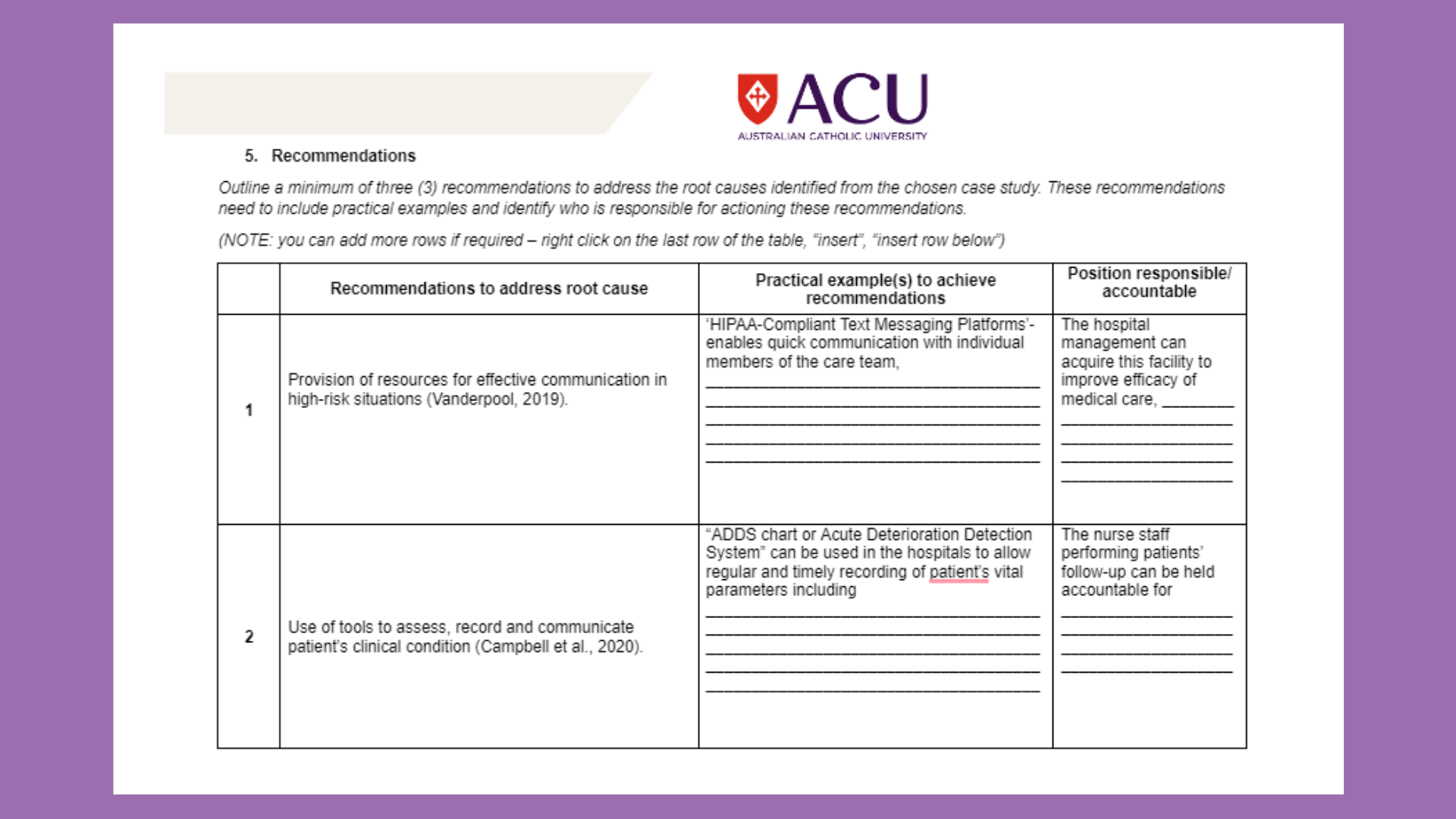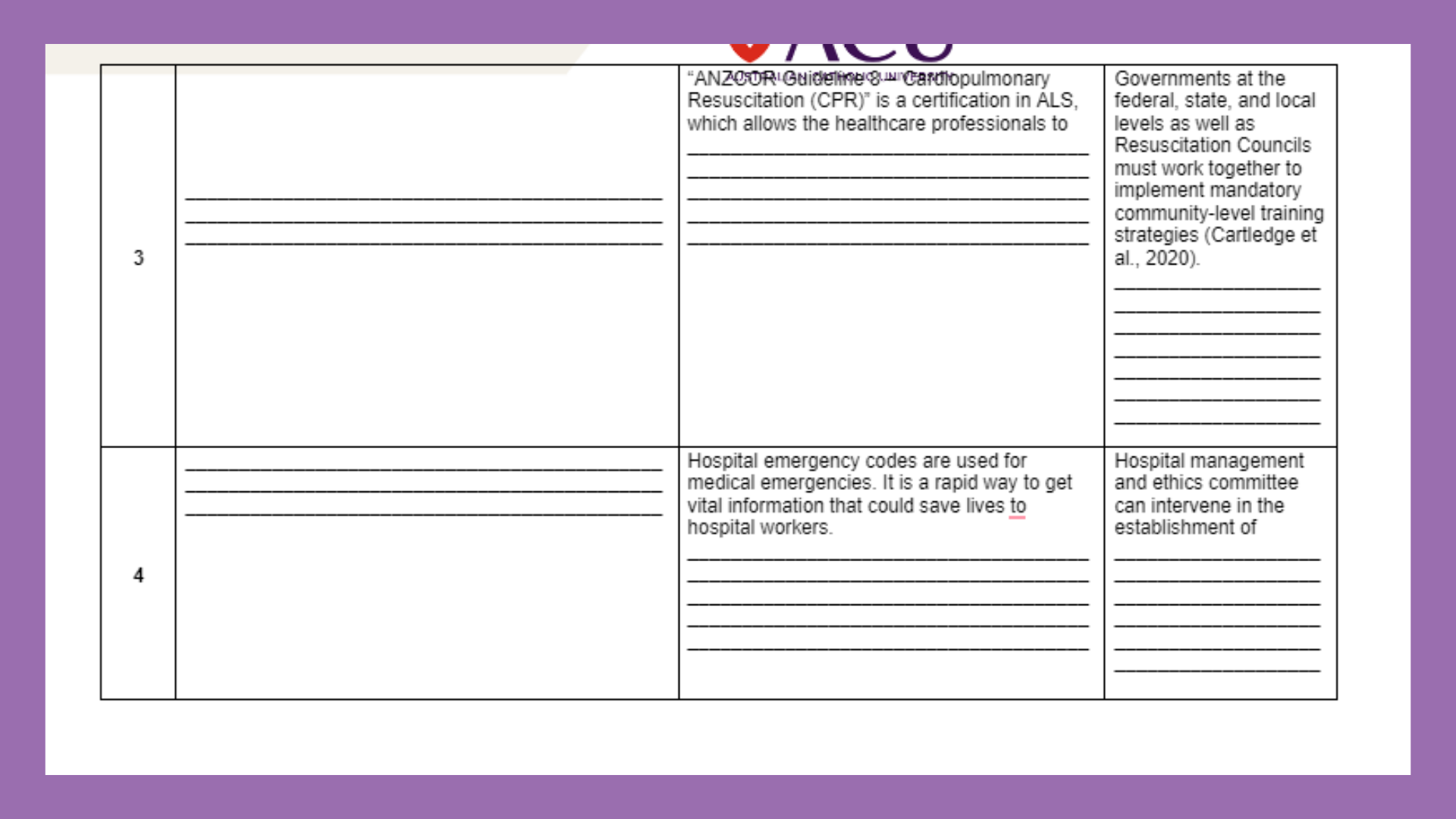NRSG378: Extended Clinical Reasoning Project Assignment Help

Question
NRSG378: This Principles of Nursing (Extended Clinical Reasoning) Project assignment for the Australian Catholic University requires the student to conduct a root cause analysis on a chosen case study and demonstrate their learnings related practical application of professional standards related to nursing and health. To complete the root cause analysis essay, the student is supposed to provide a description, root causes, an association of the causes to the NMBA and NSQHS standards, and lastly some suggestions to address the causes identified above.
Solution
The solution incorporates a comprehensive assignment on the root cause analysis of case study 1. This study revolves around the case of Mrs. Sergi, a 79-year-old woman who was admitted to the hospital for her hip replacement surgery. It is remarked that her care post-surgery did not go well as a result of which she passed away. Our experts have assessed the situation closely to identify the primary issue which led to the problem, and have conducted an in-depth root cause analysis for the same using the template provided in the assessment file.
The solution is divided into five parts- Description, Identification of root cause and contributing factors, Links to NMBA RN Standards for Practice, Links to National Safety and Quality Health Service Standards, and lastly Recommendations to address the root cause.
Introduction
Our experts have written a brief introduction detailing the case study. Our experts have written an introduction for the events that happened in the scenario to orient the reader and provide a foregrounding to the project.
I chose case study 1 which describes Mrs. Sergi as a 79-year-old woman who was admitted to the hospital for a hip replacement surgery. After an uneventful surgery, she was transferred to PACU. During her recovery, while she was improving slowly from the anaesthesia, she was handled by a number of healthcare professionals. At her discharge from the operation theatre, the Anaesthetist commenced an intravenous fluid therapy (IVFT) with 1L bag of 0.9% NaCl (normal saline). He prescribed 2L of normal saline to be administered at the rate of 100ml/ hour, until she was reviewed the next day. However, the same afternoon, at handover to the ward nurse, Fiona, the PACU staff conveyed that Mrs. Sergi needed “as much fluid as possible.”
This is only half of the introduction. Wish to read the full introduction? Call us now at +61871501720.
Identification of root cause and contributing factors
This section of the root cause analysis essay determines and elaborates on the factors responsible for the event. Along with clearly identifying the factors, our experts have also supported these with appropriate literature from credible resources.
The event described above belongs to the category of “Medication error resulting in serious harm or death” as per the “Australian sentinel events (version 2.0)” (Australian Commission on safety and Quality in Health Care, 2023). In Mrs. Sergi’s case, the administration of normal saline without assessing her state of hydration led to a state of hypervolemia, elevating her blood pressure and eventually leading to a preliminary diagnosis of acute pulmonary oedema as evident by her shortness of breath (Isaacs et al., 2021). Additionally, her agitated state of mind suggest that she became delirious as a result of tissue oedema resulting from capillary leak in hypervolemic states (Ouchi et al., 2020). The root cause is “lapse in continuum-of-care ((Holbrook et al., 2022)).” A “continuum-of-care” model helps to enhance communication among all parties involved, reduces confusion, and ensures that the right resources are provided so that patient needs are met (Davis et al., 2021).
We provide the best Nursing Case Study Assignment Help by writing comprehensive and well-referenced answers. If you also need help, please reach out to us at onlineassignmentservices1@gmail.com.

Links to NMBA RN Standards for Practice
The following section identifies two NMBA Standards which are deemed appropriate in correlation to the case study along with providing a proper reasoning behind why these standards become important in the present scenario.
The first NMBA RN standard for practice that was violated by the nurses was, Standard 4. According to this standard, the registered nurse performs assessments that are comprehensive and culturally sensitive. Mrs. Sergi was left unattended by the nurse staff without conducting frequent assessments.
The second standard that was violated was Standard 6. According to this standard, RN provides thorough and quality practise to achieve goals that meet the needs of people; practices within their scope of practise; appropriately delegates duties to ensure informed and safe patient care. In this case, Mrs. Sergi, became a victim of uninformed nursing practice (Ouchi et al., 2020).
We have provided only a snippet of the complete justifications written by our experts. Please WhatsApp us at +447956859420 to know more.
Links to National Safety and Quality Health Service (NSQHS) Standards
In this next section, our experts have identified and linked two NSHQS standards that are significant, especially to the issue highlighted in the present case study. Our experts have articulated the answers with relevant module concepts.
The first NSQHS standard that was overlooked in this case was, “communication for safety.” As per this standard, the organization with its members must use effective and timely communication to plan, revise, resume and document patient care to quickly respond to deteriorating health of patients (Australian Commission on safety and Quality in Health Care, 2023).
The second NSQHS standard that was breached was, “recognition and response to early deterioration.” The goal of standard is to guarantee that an individual’s severe deterioration is quickly identified and the proper action is performed. In addition to acute alterations in cognition and mental state, acute degradation also includes physiological changes (Vanderpool, 2019).
We observed you searching for a Clinical Reasoning Case Study Example. Look no more, please reach out to us at onlineassignmentservices1@gmail.com.
Recommendations
Based on the issue identified above and the significant national standards, the experts have proposed recommendations to address the root causes and to improve the clinical practice for the patients.


Need Extended Clinical Reasoning Project assignment help? Call us now at +61871501720.

